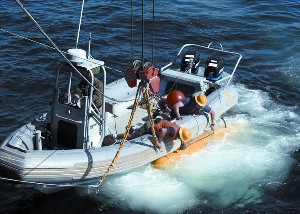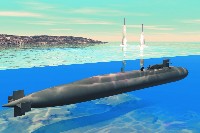Navy Faces Forks in the Road
 |
Members of the Very Shallow Waters Mine Counter Measures Command unhook a battlespace preparation autonomous underwater vehicle in the waters off the California coast. The role of autonomous vehicles in operations is one of the forks in the road for the U.S. Navy. |
Decisions that the U.S. Navy makes in key areas during the next several years could shape not only the sea service itself, but also the way U.S. and foreign militaries fight in the future. Ships and aircraft under development, next-generation weaponry, unmanned systems and joint concepts are among the issues that experts believe the Department of the Navy must address today so that alternative strategies can be analyzed well in advance of the need to take action.
New homeland defense and security requirements are bringing about change in the U.S. military. The possibility of unpredictable attacks from militant adversaries demands that all of the armed forces adopt new tactics, because Cold War methods will not neutralize asymmetric threats. However, experts agree that developing concepts, instituting policies and acquiring technologies without a clear vision of a comprehensive goal could lead the services down an unproductive and costly path. They say tactics that rely heavily on communications systems will succeed only if technology delivers the capabilities as envisioned.
To identify the macro issues that are most likely to affect the Navy’s future, the Office of the Chief of Naval Operations commissioned RAND, a nonprofit corporation headquartered in Santa Monica, California, to research the topic to determine the “forks in the road” for the next few years. Rear Adm. Frank W. Lacroix, USN (Ret.), and Irving N. Blickstein, both senior military researchers in RAND’s National Defense Research Institute, conducted the study.
Blickstein and Adm. Lacroix interviewed active duty and retired naval personnel as well as other RAND analysts to gain insight about overarching decision areas rather than specific programs or technologies. To qualify as a fork in the road, the issue had to meet specific criteria. Only mandatory decision points with multiple alternative paths were included in the final list. The decision had to set a long-term direction, involve investment as well as operational aspects and include several naval communities. Finally, a true fork in the road would usually include significant resource decisions and imply an opportunity to transform.
The researchers identified more than 65 important decision points from the interviews. Because Blickstein and Adm. Lacroix did not believe the points were equally important, they evaluated this list in terms of opportunities and risks. As an opportunity, the decision would affect national policy, effectively use personnel, promote efficiency, employ future technology, enable jointness, improve warfighting or qualify as transformational. The risks included easy negation by an adversary, a high probability of a cost increase, conflict with naval culture or doctrine, the overestimation of technological capabilities or the possibility of rapid obsolescence. As a result of the analysis, Blickstein and Adm. Lacroix identified 11 forks in the road.
The issue of global maritime tracking in homeland defense must be addressed, they found. As it stands today, the Navy and the U.S. Coast Guard share security responsibilities in the maritime domain, and experts interviewed agreed that it is not clear that the Navy believes that responding to an attack on the United States from seaborne platforms is currently its responsibility.
Another key decision area concerns the Navy’s vision of its role in the joint environment. Although the Navy supports the U.S. Marine Corps, it must determine how it will cooperate and collaborate with the other services as well as with the Coast Guard and U.S. Department of Homeland Security in the future.
Naval support of joint operations also relates to a fork in the road: transitioning the aircraft carrier to a joint aviation platform. Traditionally, carriers have supported only Navy and Marine Corps aircraft. Navy leaders must consider how joint forces will fight in the future and choose a design for future sea-air platforms that supports the vision, interviewees agreed. The experts pointed out that there might be some advantages to developing platforms that consist of modules that can be installed or removed depending on the nature of the mission.
Experts indicated that decisions about other platforms also will need to be made. With the effectiveness of the land-based intercontinental ballistic missile force in question, the nation’s defense could depend on submarines for strategic deterrence. The projected life span of Trident submarines is 42 years, and some of the current fleet will reach the end of service during the next 15 years. As a result, Navy leaders must begin to consider their replacement.
Many of the experts Blickstein and Adm. Lacroix consulted believe that electronic and laser weapons would be feasible within 15 years. Decisions about the role of electronics in both platforms and weaponry will be a fork in the road for the Navy, they said. In addition, research participants concurred that the small-diameter bomb, currently under development by the U.S. Air Force, holds great promise for the Navy. The reduction in weight has strategic implications, as naval aircraft could extend their range.
Blickstein and Adm. Lacroix also identified two other areas that, despite higher risk than the others, would offer benefits worth considering. The role of unmanned platforms has expanded in missions since Kosovo operations. Although usage has grown, the concepts of operations are still in their infancy, the researchers say. One major decision point for the Navy will be how best to use these vehicles and integrate them with manned platforms. Additionally, the Navy’s growing dependence on space-based platforms requires that the service be involved in the decisions made about military involvement in space, they stated.
 |
As the submarine fleet ages, Navy leaders will have to make decisions about the future of the platforms. Four Ohio-class strategic missile submarines already have been selected for transformation into a new platform called the Tactical Trident. These vessels will be able to carry and launch up to 154 Tomahawk missiles and may carry other payloads, including unmanned underwater and aerial vehicles, as well as special forces equipment. |
Capt. Wayne Perras, USN (Ret.), director, Sea Trial, Navy Warfare Development Command, Newport, Rhode Island, reviewed the RAND report and says that the researchers have generated a very good set of challenges that the Navy must face in the future. While the authors of the study took an operational approach, Capt. Perras’ view is from the fleet perspective. Although he shares their opinions about a majority of the topics, he takes it a step further with his position that priorities also must be identified.
The first tier includes two items listed in the report. The captain believes that sea basing is the most important issue because it affects joint forces and mission strategies. Being able to bring warfighters to a battlespace and effectively support them throughout an operation is powerful. The need for this capability already has been demonstrated with the reluctance of some countries to provide locations near a battlespace from which U.S. militaries and allies can operate.
Recognizing the Navy’s joint role is the second item in Capt. Perras’ first tier of issues. It is a corollary to sea basing. Joint operations are the enabler for projecting force around the world without relying on forward-deployed forces that probably will not be there, he says. Discussions about, for example, the design of aircraft carriers are a subset of the overall decision about the Navy’s joint role and sea basing.
Information technology is Capt. Perras’ third topic in his first tier, and he believes study participants did not appreciate the importance of this topic. Although Blickstein and Adm. Lacroix discussed how information technology could affect personnel relocation, Capt. Perras says the issue is more complex. For instance, connecting warfighters can be accomplished technologically, but information overload continues to be a challenge. The goal of providing information must be better command and control. The captain points out that simply giving commanders a great deal of data does not necessarily improve command and control. “And it clearly doesn’t reduce your manpower. It means you have to have a lot more people to deal with all that information,” he says.
In addition, other information technology issues must be addressed such as multilevel security, dynamic mobile networking, reliable networking and high-level data fusion. It will be difficult to accomplish in the next 10 to 15 years because the services must continue to operate while managing legacy systems and building for the future. Although the information from legacy systems can be merged appropriately from the standpoint of syntax, the captain does not believe it can be brought together semantically. The power of information cannot truly be realized until the latter is achieved, he says.
Because today’s technologies cannot put data into context, human analysts are called on to provide the semantics. Even when knowledge management technologies are developed, the issue of trust will have to be addressed so that commanders have confidence in the analysis, he adds.
“I think the Navy and the Department of Defense need to make some major decisions about how to move forward to build the infrastructure that will enable us to do these things. It’s about more than just communications. Yes, that’s necessary, but it isn’t sufficient. And I think most of what most people see and what you’ve heard about network-centric warfare is that the power is in just connecting the dots,” Capt. Perras maintains. An overload of information can lead to chaos, he contends, and a well-designed, reliable infrastructure helps warfighters overcome the chaos and bring the real power of information to the battlefield. These are some interesting challenges for the future that must be addressed before the Navy can move forward on sea basing and its joint role, he states.
Capt. Perras’ second group of priorities begins with the autonomous vehicle issue, and he says the Navy must make some decisions in this arena soon. “We either stay with manned vehicles for good reason and pay the overhead of having a manned vehicle, or we make a decision pretty rapidly to move in a different direction. But to make that decision, we really have to move the technology in terms of autonomy in a different direction, and I don’t know if we’ve made that decision,” he says.
The second issue in this tier concerns the decision point raised in Blickstein and Adm. Lacroix’s research of future weapons. The Navy is moving toward electric ships, and the transition to laser and electronic weapons flows from that decision. These weapons would do more than just increase lethality. The cargo space formerly needed for storing ammunition could be used for materiel that supports the sea-basing concept, the captain notes. He believes the Navy is close to making a decision on this issue, but the road to achieving this goal is long, and considerable funds will be spent to achieve it, Capt. Perras says. However, Navy leaders appear to agree that they are moving in the right direction.
The final part of the captain’s second tier also involves technology. While the RAND report points to technology only as a way to reorganize personnel assignments, Capt. Perras predicts that the introduction of advanced communications systems will have a much broader effect on the Navy, including changing the way it fights. Networking capabilities that enable the military to compose a force in minutes rather than months are the type of capabilities that militaries want.
Although innovative technologies are part of achieving this objective, Capt. Perras contends that developing concepts and strategies for future warfighting is the crux of the matter. Rather than searching for how technologies can be inserted into the battlespace, the captain maintains that the services must first determine how they want to fight, then push for research and development of capabilities that support that vision.
Additional information on RAND is available on the World Wide Web at http://www.rand.org.



Comments